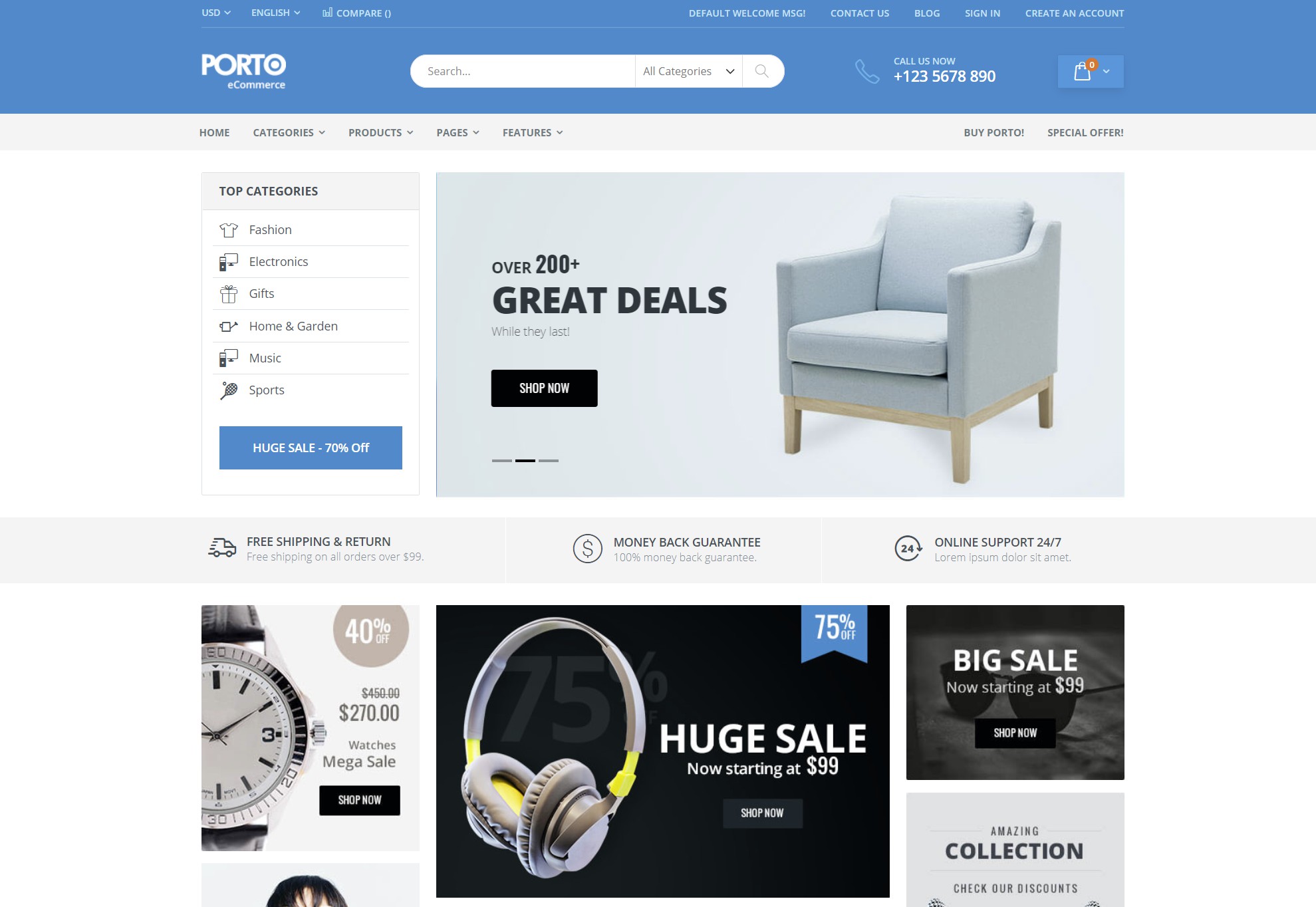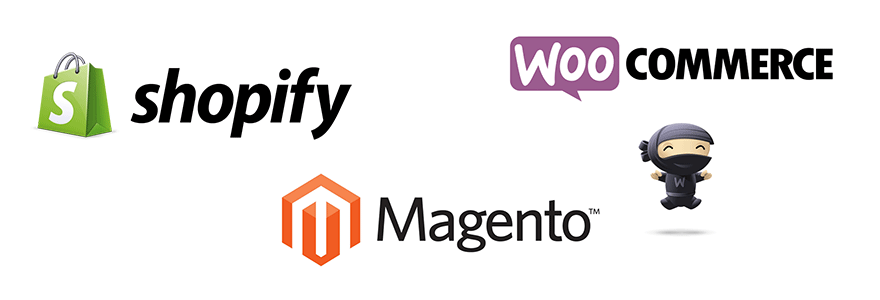- By Colin Newcomer
- Last updated: December 23, 2019
If you’re thinking of launching an eCommerce store, you’re definitely not alone. Consumers are spending increasingly higher amounts online, with spending up 14.2% in 2018, compared with 2017. To meet that growth, more and more brands, both big and small, are launching online stores.
If you want to launch your own online store, you’ve probably come across three names — Shopify, Magento and WooCommerce. By the numbers, these three tools are the most popular ways to create an online store, with WooCommerce and Shopify neck-and-neck at the top and Magento in a more distant third place.
All three also have billion-dollar companies behind them, which should give you confidence that they’ll be around to update and enhance the software going forward.
But, while all three tools are popular and well-supported, they all have big differences when it comes to their strengths and weaknesses.
Shopify offers the simplest way to start selling online, but at the sake of some flexibility. Magento offers enterprise-level flexibility, but at the cost of ease of use. And WooCommerce sits somewhere in the middle, offering a good amount of flexibility while still staying fairly easy to use.
So, with such differences, how do you pick the best eCommerce platform for your specific situation? To help you to make your decision, we’re going to compare Shopify, Magento and WooCommerce.
We’ll cover each platform’s strengths and weaknesses, and discuss what type of store each is best suited to, to help you to decide on the best one for you.
Let’s get started.
Shopify
Founded in 2004, Shopify holds a 21% market share when you look at eCommerce sites in the BuiltWith Top 1 Million, which puts it narrowly in second place right behind WooCommerce. In May 2015, it filed for an IPO at $17 a share, and the stock has absolutely soared since then to $372, putting Shopify’s 2019 market cap at $43 billion. So yeah, Shopify has been rapidly growing over the past few years and has a lot of momentum behind it.

The main differentiator with Shopify is that it offers the absolute most streamlined approach to setting up an online store.
In fact, you don’t even have to worry about finding a hosting provider or installing any software — it’s all included. Shopify’s hosting service is high quality and includes unlimited bandwidth, a built-in CDN, and automatic site backups. Additionally, Shopify handles updating and maintaining the underlying software for you — which is not the case with WooCommerce or Magento.
That means all you need to do is sign up for an account, choose a theme and start adding products — though you can add a custom domain should you wish (recommended).
All of the necessary eCommerce functionality is supported out of the box, so you won’t need to give a moment’s thought to setting up a secure shopping cart, creating a system for tracking orders or implementing a payment gateway.
This brings me to the next point: Your shop’s design, which is determined by your choice of theme. These professionally designed themes work very much like WordPress themes: They provide a template for the design and aesthetics of your site, as well as some base functionalities.
You can find both official Shopify themes, as well as themes from third-party developers. Shopify currently offers 72 official themes — eight free themes and 64 premium options priced between $140 and $180.

(Theme details)
Most themes come with lots of options, and you can customize your site’s design using Shopify’s intuitive user interface. This means there’s no need to ever touch a line of code — although developers are free to make custom tweaks by editing the HTML and CSS directly.
It’s also worth pointing out that, although the themes are primarily built for eCommerce, they do also support blogging capabilities for those looking to dabble in content marketing.
As with WordPress, you can also extend your store’s functionality with apps. The Shopify App Store contains thousands of apps for a variety of uses, including live chat, drop-shipping, automatic currency conversion, variable shipping rates and accounting software.
While some apps are free, many of them require you to pay on a monthly basis.
One thing you don’t get, though, is direct access to your server for full customization flexibility. Shopify is a hosted solution, which means you don’t get access to the underlying software like you do with WooCommerce and Magento. If you need to customize your store in ways you can’t do with apps, HTML/CSS or themes, then this could cause issues.
To use Shopify, you’ll need to sign up for one of its three plans:
- Basic Shopify, $29 a month — this is the no-frills option, with online transaction fees fixed at 2.9% + 30c.
- Shopify, $79 a month — this plan includes support for gift cards and professional reports, with the online transaction fee dropping to 2.6% + 30c.
- Advanced Shopify, $299 a month — all of the features of the other plans, plus advanced report builder functionality and real-time carrier shipping. Online transaction fees drop again to 2.4% + 30c.
It’s important to note that those payment processing fees assume you use the official Shopify Payments service. If you want to use your own payment processor (such as Stripe or PayPal), Shopify charges an extra fee on top of what that payment processor charges. This fee varies from 2% to 0.5% depending on your plan.
Shopify also offers an enterprise-focused plan with more flexibility, called Shopify Plus, which starts at $2,000 a month minimum.
If you want to see Shopify in action, you can check out these great Shopify examples.
Summary
Shopify is a very accomplished eCommerce platform; its interface is easy enough for a beginner to get to grips with, but powerful enough for more experienced users and larger eCommerce stores as well.
The back end has everything you need to run your eCommerce store — this includes uploading and categorizing products (with support for unlimited products), specifying attributes and managing orders. Shopify also supports powerful SEO functionality and has advanced analytics built-in.
With your hosting, security and maintenance covered, you’re free to spend your time focusing on growing your store, and, because of Shopify’s ease of use, you can be up and running in hours, not days.
The only potential downside of this simplicity is that you can’t edit 100% of your store’s underlying code like you can with Magento or WooCommerce. Still, most ‘normal’ eCommerce stores probably won’t run into any issues with that limitation, which is why Shopify has been so successful.
Magento
Next, we have Magento. Founded in 2008, Magento has bounced around different owners (including eBay) before eventually being acquired by Adobe in 2018. By the numbers, Magento powers ~9% of eCommerce stores in the top million sites, which puts it in a distant third place behind Shopify and WooCommerce.

There are two different ways to use the Magento software:
- You can install the free, open-source Magento software on your own web hosting, much like you can WordPress. This is called the Community Edition — you can download it here.
- You can pay for Magento Enterprise Edition, which starts at $22,000 and goes up from there.
Because the Enterprise Edition is so pricey, we’re going to focus on the free, open-source Community Edition.
With the Community Edition, you’ll face a considerably steeper learning curve than with Shopify — if you’re a skilled developer, this won’t be a problem, but if your technical skills are way below par you’re probably better off looking elsewhere.
To install Magento, you need to find your own hosting account — preferably a specialist that can cater to the resource-heavy needs of a Magento website.
You’ll need to install themes to determine your site’s design, and extensions to enhance its functionality (the Magento equivalent of WordPress plugins). The official store offers a good selection of themes and extensions, or you can buy from third-party marketplaces.
A quick word of warning: Themes and extensions for Magento can be expensive, especially if you’re used to WordPress product prices. For example, it’s common to see extensions or themes cost $300+-plus (though you can find cheaper options, as well).

(Theme details)
This is where the similarities between Magento and WordPress end. The one major difference between the two is obvious: Magento is exclusively an eCommerce platform. Magento is also quite complex — it’s likely you’ll need to hire a developer to perform even simple tasks, such as installing extensions.
The Magento core, however, is the most powerful eCommerce platform there is, and boasts an impressive list of features. There are too many to list in full here (if you want to see them all, take a look at this page), but here are some of the features/abilities you get access to:
- Up-sell and cross-sell related products, and create product bundles.
- Dedicated landing pages for each category of products.
- Flexible coupon codes and pricing rules.
- Manage all Magento stores from one admin panel.
- Show unlimited product attributes — size, color, style and so on.
- Dedicated account dashboard for registered customers.
- One-page checkout.
- Built-in wish list functionality.
- Rewrite URLs for SEO.
This is in addition to all of the other core eCommerce functionality — product pages, shopping carts, payment gateways, order management and so on — that’s essential for online stores. By default, the PayPal and Authorize.net gateways are built-in, but you can integrate plenty of others using extensions.
Summary
Without a doubt, Magento is the most powerful eCommerce platform featured on this list. It’s pretty complex to use, but this is more than made up for by the sheer quantity of features it supports.
Although the core is free to use, many non-developers will struggle to get their store up and running without assistance. This could add significant development costs to the price, which would rule Magento out for low-budget operations.
Still, if you have the money, Magento offers all of the functionality an eCommerce store could possibly need. With support for unlimited products (and variables), Magento is arguably one of the most flexible and scalable eCommerce solutions around.
WooCommerce
Finally, we have an eCommerce solution that all WordPress users should be familiar with: WooCommerce. By the numbers, WooCommerce is the most popular way to make an eCommerce store, holding a 22% market share, which puts it slightly ahead of Shopify for first place.
WooCommerce was acquired by Automattic in May 2015 — in a deal worth a reported $30 million. If you’re not familiar, Automattic is the company behind WordPress.com, with its most recent valuation at $3 billion. We only share that number to demonstrate that WooCommerce, like the others, has the resources of a billion-dollar company behind it.

Rather than being an all-in-one-solution (like the two dedicated eCommerce platforms featured so far), WooCommerce is actually a WordPress plugin — meaning you’ll need a website powered by WordPress to run it.
Like the core WordPress software, the core WooCommerce plugin is also free, although you’ll likely need to purchase some premium extensions to create a functioning store.
WooCommerce gives your website eCommerce functionality out of the box. After installation, you’ll be able to upload products to your website — including images, descriptions, prices, variable attributes, and specifications — and visitors will be able to add them to their cart, then head to the checkout to pay for them.
To help you to set up your store, WooCommerce comes with a convenient setup wizard that helps you to connect to payment processors, such as Stripe or PayPal, set up shipping zones and more.
WooCommerce also comes with tools to help you to automatically calculate taxes and shipping rates.
It’s also one of the most intuitive eCommerce platforms; WordPress users will feel right at home, as all order management is handled from the familiar WordPress back end.
Of course, one of the most important factors when launching a store is your site’s design. Thankfully, most WordPress themes support WooCommerce out of the box, and you’ll also find thousands of dedicated WooCommerce themes for every niche under the sun at WordPress.org and marketplaces such as ThemeForest:

(Theme details)
Where WooCommerce really excels is the extension marketplace. Because it’s built on WordPress, you can avail yourself of the 50,000-plus free plugins at WordPress.org, as well as thousands of premium options. Additionally, because WooCommerce is so popular, you can also find thousands of plugins specifically dedicated to extending WooCommerce.
In fact, if you search for ‘WooCommerce’ at WordPress.org, you’ll find almost a thousand free WooCommerce plugins (our favorites). And the extension marketplace at the WooCommerce website showcases another 330-plus free and premium extensions.
Some of my favorite extensions include:
- WooCommerce Subscriptions ($199) — allows you to collect recurring payments from customers.
- Product Add-ons ($49) — lets visitors customize their products further (for example, specify engravings).
- Smart Coupons ($99) — lets you create promotional deals or even offer gift certificates to your store.
- Dynamic Pricing ($129) — lets you use dynamic, flexible prices by configuring an unlimited number of pricing ‘rules’.
- WooCommerce Bookings ($249) — lets you accept appointment bookings via your store.
Want to see what a good WooCommerce store looks like? Here are some great examples.
Summary
WooCommerce is already the most popular eCommerce solution, and it’s certainly one of the best. Boosted by the phenomenal success of WordPress, WooCommerce gives webmasters the opportunity to bolt an eCommerce store on to any WordPress-powered website.
If you’re a WordPress user, you should be able to adapt to WooCommerce seamlessly, as everything is controlled from within the standard WordPress dashboard — from building and customizing your store to adding products and handling orders.
The core perhaps lacks the absolute power of Magento but makes up for it with its impressive usability. And, should you want to add more features to bring it more in line with Magento, there are plenty of extensions that allow you to do so.
Basically, if you want something that’s more flexible than Shopify, but not as intimidating as Magento, then WooCommerce is a great option.
Final Thoughts
Having examined Shopify, Magento and WooCommerce, the big question is: Which should you choose?
As is often the case with these types of questions, the honest answer is: It depends. There are a lot of factors at play when deciding which eCommerce platform to use — your technical skills, budget, size of store and the features required, to name just a few. However, there are three scenarios where the answer is clear cut.
- You have limited technical skills, and you’re simply looking for the quickest way to launch your store with minimal fuss — go with Shopify.
- You have a large budget to play with, and you’re looking for the most powerful solution to launch an enterprise-sized store — go with Magento.
- You aren’t afraid to learn how to do things for yourself and want a solution that will grow with your business without limiting its potential — go with WooCommerce.
But what if you don’t fall neatly into one of those three categories? Well, perhaps I’m biased writing for a WordPress blog, but I feel WooCommerce is a great starting point. As I mentioned above, it hits the middle ground between these other two tools, offering somewhat of the best of both worlds, with good ease of use, affordability and more flexibility than Shopify offers.
Of course, I’m not alone in feeling that way — remember that WooCommerce holds the highest market share, beating out both Shopify and Magento (though Shopify is tight on its tail).
Anyone who’s used WordPress should have no problem figuring out WooCommerce and launching an online store. And anyone who hasn’t? Well, WordPress is intuitive to use, and there are far more helpful WordPress resources out there (including WinningWP, of course) than for Shopify or Magento.
With plenty of awesome features (and plenty more available via extensions), a low cost, and a small learning curve — if in doubt, go with WooCommerce.
So, Shopify, Magento or WooCommerce? Thoughts?
Colin Newcomer is a freelance writer and long-time Internet marketer. He specializes in digital marketing and WordPress. He lives a life of danger, riding a scooter through the chaos of Hanoi.
Keep reading the article at WinningWP. The article was originally written by Colin Newcomer on 2019-12-16 04:28:01.
The article was hand-picked and curated for you by the Editorial Team of WP Archives.

